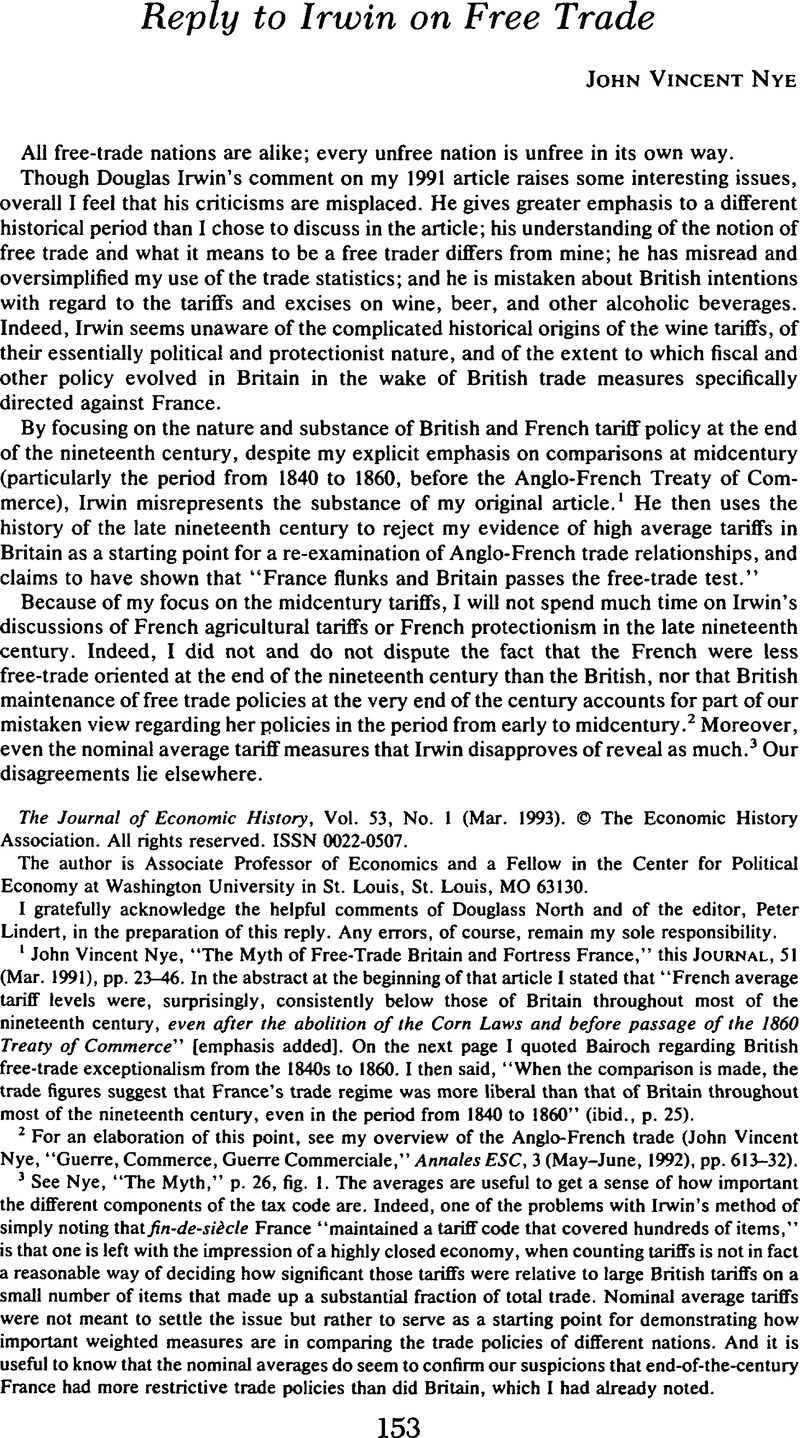Published online by Cambridge University Press: 03 March 2009

1 Nye, John Vincent, “The Myth of Free-Trade Britain and Fortress France,” this JOURNAL, 51 (03 1991), pp. 23–46.Google Scholar In the abstract at the beginning of that article I stated that “French average tariff levels were, surprisingly, consistently below those of Britain throughout most of the nineteenth century, even after the abolition of the Corn Laws and before passage of the 1860 Treaty of Commerce” [emphasis added]. On the next page I quoted Bairoch regarding British free-trade exceptionalism from the 1840s to 1860. I then said, “When the comparison is made, the trade figures suggest that France's trade regime was more liberal than that of Britain throughout most of the nineteenth century, even in the period from 1840 to 1860” (ibid., p. 25).
2 For an elaboration of this point, see my overview of the Anglo-French trade (Nye, John Vincent, “Guerre, Commerce, Guerre Commerciale,” Annales ESC, 3 (05–06 1992), pp. 613–32).Google Scholar
3 See Nye, , “The Myth,” p. 26Google Scholar, fig. 1. The averages are useful to get a sense of how important the different components of the tax code are. Indeed, one of the problems with Irwin's method of simply noting that fin-de-siècle France “maintained a tariff code that covered hundreds of items,” is that one is left with the impression of a highly closed economy, when counting tariffs is not in fact a reasonable way of deciding how significant those tariffs were relative to large British tariffs on a small number of items that made up a substantial fraction of total trade. Nominal average tariffs were not meant to settle the issue but rather to serve as a starting point for demonstrating how important weighted measures are in comparing the trade policies of different nations. And it is useful to know that the nominal averages do seem to confirm our suspicions that end-of-the-century France had more restrictive trade policies than did Britain, which I had already noted.
4 Gandolfo, Giancarlo, International Economics: Book 1 (Berlin, 1986).CrossRefGoogle Scholar
5 For instance, more than a few commentators have noted that the U.S. luxury tax on automobiles costing over $30,000 differentially burdens foreign manufacturers, who dominate that end of the market—and that this is no accident.
6 I address the historical consequences of British policy from 1689 to 1860 with respect to alcoholic beverages at home and abroad on British consumption habits and on French income, as well as the implications for British trade policy, in a work in progress tentatively titled “The Unbearable Lightness of Drink: British Wine Tariffs and French National Income, 1689–1860.”
7 In the 1850s the average tariff on all wine imported into Britain ranged from about 45 to 85 percent. This dropped to about 25 to 30 percent in the decades following the treaty, whereas beer excises on all domestic production averaged about 12 to 18 percent ad valorem before the treaty and between 10 and 15 percent afterward.
8 France, Ministère du Commerce, Annuaire Statistique de la France (Paris, 1884), pp. 340–41.Google Scholar
9 Price quotes from the Journal d'Agriculture Pratique (new period, 1859, tome 2)Google Scholar give market prices for the cheaper wines in 1858 and 1859 trading in France at roughly 13 to 18 francs per hectoliter, which would come to under 20s. per barrel. Even after I added a generous markup, this again suggested a lower price per barrel than beer in Britain, with an effective ad valorem tariff of more than 100 percent.
10 Though we do not know the exact types of wines imported into Britain from France, we do have one useful proxy, the ratio of bottled to barrel wines by volume. Wines imported in bottles were only of the best kind, because they were expensive to transport and liable to breakage. For most countries, the French trade statistics indicate a ratio of 1 bottle to 20 barrels or more by volume. Britain is unique in having a ratio of 1 to 3, again indicating that the British duties essentially cut out the low end of the wine market (France, , Archives Nationales, F20744Google Scholar). Indeed, since the 1700s it had been typical for the British market to obtain a disproportionately large share of the high-end Bordeaux output, because those wines would have been less seriously affected by the volume tariffs.
11 This comparison is particularly appropriate because the French specialized in high-quality woolens, silks, and linens. The fear was that low ad valorem rates would mean that much larger quantities of the cheap British cottons would “flood” the French market. The French protectionists were not mistaken: very large amounts of British cottons of all types were imported from 1860 on. The French protectionists were also justified in worrying that the ad valorem rates would not be enforced systematically, as underreporting was always a serious problem (and one not shared by the British specific duty on French wine).
12 Nye, , “The Myth,” p. 33.Google Scholar
13 For France, the only category that seriously affected overall tariff averages was tariffs on agriculture. Not surprisingly, the overall French average tariff rose or fell depending on major changes in duties on imported grain.
14 See, for example, Imlah, Albert, Economic Elements of the Pax Britannica (New York, 1958)CrossRefGoogle Scholar; and McCloskey, Donald, “Magnanimous Albion: Free Trade and British National Income, 1841–1881,” Explorations in Economic History, 2nd series 17 (07 1980), pp. 303–20.CrossRefGoogle Scholar
15 See Bairoch, Paul, “European Trade Policy, 1815–1914,” in Mathias, Peter and Pollard, Sydney, eds., The Cambridge Economic History of Europe, vol. 8: The Industrial Economies: The Development of Economic and Social Policies (Cambridge, 1989), pp. 1–160.Google Scholar